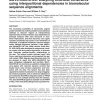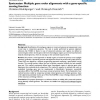372 search results - page 23 / 75 » An Efficient Method for Multiple Sequence Alignment |
NAR
2006
13 years 8 months ago
2006
The increasing availability of structurally aligned protein families has made it possible to use statistical methods to discover regions of interpositional dependenciesof residue ...
BMCBI
2004
13 years 7 months ago
2004
Background: The prediction of ancestral protein sequences from multiple sequence alignments is useful for many bioinformatics analyses. Predicting ancestral sequences is not a sim...
BMCBI
2006
13 years 8 months ago
2006
Background: Several entropy-based methods have been developed for scoring sequence conservation in protein multiple sequence alignments. High scoring amino acid positions may corr...
WABI
2005
Springer
14 years 1 months ago
2005
Springer
In contrast to proteins, many classes of functionally related RNA molecules show a rather weak sequence conservation but instead a fairly well conserved secondary structure. Hence ...
ALMOB
2008
13 years 8 months ago
2008
Background: Identification of homologous regions or conserved syntenies across genomes is one crucial step in comparative genomics. This task is usually performed by genome alignm...


